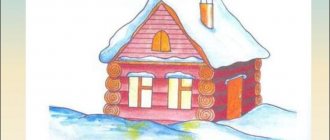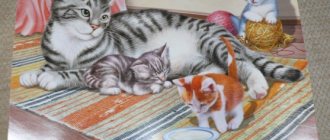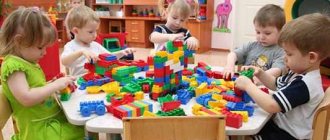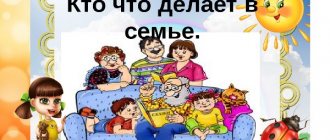LESSON SUMMARY ON COMPILING A CREATIVE STORY BASED ON A PICTURE USING TRIZ TECHNOLOGY
The material was published in the January printed collection of practice-oriented materials “Preschool and primary education - modern methods and technologies of teaching and upbringing”
Levashina Alena Stepanovna
teacher
MBDOU ZATO d/s No. 30
Severomorsk, Murmansk region.
LESSON SUMMARY ON COMPILING A CREATIVE STORY BASED ON A PICTURE USING TRIZ TECHNOLOGY
Tasks:
- Continue learning to find and name as many objects in the picture as possible.
- Strengthen the ability to find parts of objects.
- Teach children to see and combine the interactions of objects on the physical and emotional-spiritual level.
- Learn to write riddles based on comparisons.
- Teach children to “remember” the past and imagine the future of the objects depicted in the picture.
- Exercise children in composing coherent texts based on various sensations.
- Learn to compose a story on behalf of the character you have taken on.
Advertising message
Material : painting.
Progress of the lesson:
Educator: the wizard “Delhi” came to visit us with his magic binoculars. List who you see in the picture, what else can be seen in it.
Children: hare, snow, fox, trees, hummocks, dry grass, hare's shadow, sky, clouds, etc.
Educator: the “Unite” wizard loves to combine everything, to connect all objects with each other. What will he unite in this picture?
Children: hare and snow: he runs, escaping from the fox in the snow; fox and Christmas tree: the fox jumps over a small Christmas tree, catching up with the hare; birch and earth: birch grows on the ground, and its roots drink water; Fox and Hare: The fox is hunting the hare.
Educator: What do you think, can a branch be connected to the ground?
Children: yes, a branch grows on a tree, and the tree stands on the ground and takes juice from it.
Educator: are all the trees here the same?
Children: no, some are tall, others are short. The birch is tall, and the spruce is short.
Educator: The birch is slender, like...? (stick, pillar, soldier, ballerina)
Spruce needles are prickly, like...? (hedgehog, knife, icicle, fork, pin). How do Christmas trees differ from each other?
Children: one tall and fluffy; and the other is low and smoother, and the third is the lowest, it is so low that the fox jumps over it.
Educator: fluffy spruce, how...? (fur, snow, cotton wool). What kind of hare?
Children: he is white, like snow, like milk, etc.
Educator: what kind of ears does he have? Like what?
Children: long, like a dog’s ears, like a stick, like a stalk.
Educator: what can you compare the running of a hare to?
Children: runs like an arrow, like a bicycle, like a horse, like a race, like a cheetah, like a kangaroo, like a motorcycle.
Educator: what is the fox doing?
Children: jumps up to quickly catch up with the hare, she is hungry.
Educator: what kind of tail does a fox have?
Children: fluffy, like... (brush, broom, Christmas tree, fur coat, etc....)
Educator: imagine that you are a cowardly hare, how do you feel?
Tell me.
Children: fear, horror, cold, sadness, etc...
Educator: now come up with a riddle about the objects you see in the picture.
Children: fast, but not a horse.
Cautious, but not a scout.
Soft, but not snow. Who is this? (Hare)
Fluffy, but not a fur coat;
Red, but not fire;
Throwing, but not a broom. (Fox's tail).
Physical exercise: “One, two, three, freeze: show me what you see in the picture.”
Educator: imagine that you are in this forest. What do you hear?
Children: (close their eyes) - a strong wind is blowing, the grass is rustling, a mouse is squeaking under the snow, the snow is crunching under the paws of the fox and the hare.
Educator: what smells do you smell?
Children: it smells of freshness, pine needles, snow...
Educator: touch the bunny, how do you feel.
Children: the fur is soft, coolish, smooth, fluffy.
Educator: what about the tree?
Children: hard, rough, smooth branches.
Educator: Let's become wizards and determine the time of year and time of day. What season?
Children: winter.
Educator: Day or evening?
Children: day.
Educator: What happened to the hare in the morning?
Children: he woke up hungry and went to look for food. There was a village nearby, he ran into the yard, found cabbage leaves, ate them, and rode off further to look for dry grass.
Teacher: what will happen to him late in the evening?
Children: hide and go to bed, an owl will attack him.
Educator: What do you think happened to him last summer?
Children: he was a small bunny, gray in color. He nibbled green grass, his mother took care of him.
Educator: Let's imagine that we are in a picture and each of you will turn into something or someone and come up with your own story about what he sees in the picture. Don't name your story.
For example:
"A Blade of Grass."
I am a blade of grass. Last year it grew up, was green and fluttered in the wind, but autumn came, and I turned yellow, no one began to eat me, then it snowed, and I was left hanging around all winter. The wind was blowing strongly, but it couldn’t handle me, because I was almost completely covered in snow, I was warm. How good it is to be a blade of grass - the fox won’t eat me, but if only the bunny doesn’t notice.
"Sly Fox".
"Bunny."
"Christmas tree."
Summary: What do you remember most? Children's answers.
Draw a bunny at home who ran away from the fox or a fox who made friends with the bunny.
Bibliography:
1. Belousova L.E. “Amazing Stories” St. Petersburg “Childhood – Press” 2003.
2. Sidorchuk T.A., Kuznetsova A.B., “Training in composing creative stories based on a picture” Moscow, 2006.
3. Strauning A.M. “Methods for activating the thinking of preschoolers.”




